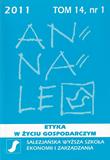Rodzinny kapitał społeczny a wzrost gospodarczy – analiza dla Polski i 15 krajów Unii Europejskiej
Family Social Capital and Economic Growth – Analysis for Poland and 15 EU Countries
Author(s): Paweł Baranowski, Jan Jacek SztaudyngerSubject(s): Economy
Published by: Wydawnictwo Uniwersytetu Łódzkiego
Keywords: divorces; economic growth; social capital; family-based social capital; family; family breakdown;
Summary/Abstract: Social capital representing among other things voluntary cooperation, social networks density and generalized trust has become popular in economics in the 90s. A number of papers has confirmed positive relationship between social capital measures and economic growth. In our opinion family-based social capital (representing the integrity of families) is important component of social capital. Sociological and psychological knowledge allow us to identify the family as a source of human bonds, man’s happiness and life quality. Presumably happy persons better fulfill their social and economic roles. For example – they work and cooperate more efficiently. Therefore, we have formulated a hypothesis that the family social capital – family bonds – have an influence on economic growth. Being more precise, the bigger the number of divorces in relation to contracted marriages as an indicator of family disintegration, the slower is economic growth. This hypothesis has been confirmed in the Polish economy in the years 1963–2006 as well as in the 15 European Union countries panel data (1972–2007). The estimations are based on the econometric model of GDP growth, into which, alongside the divorces/marriages ratio (family disintegration) investment rate, labour growth and CPI inflation have been introduced. Our results indicate that when divorces/marriages ratio rise by 10 p.p. economic growth lowers in 15 European Union countries by 0.5 p.p. The same in Poland makes economic growth lower by 1.8 p.p. These results are not fully comparable, due to differences in model specification and analyzed periods.
Journal: Annales. Etyka w Życiu Gospodarczym
- Issue Year: 14/2011
- Issue No: 1
- Page Range: 157-170
- Page Count: 14
- Language: Polish

